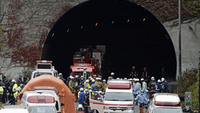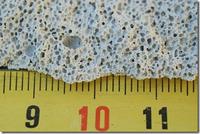-
Uranium mining debate divides Virginia
In Virginia a fight has begun over whether to drill for uranium. Some feel the drilling, which would create about 1,000 jobs and bounty of tax revenue in addition to nuclear fuel, is important for a state whose main industries, such as tobacco and textiles, are failing. Those who oppose the drilling fear the contamination of drinking water in case of an accident, and a stigma from uranium which would deter people and businesses from moving to the area.
-
-
The humble jute serves as a sustainable reinforcement for concrete
Fashionable people may turn up their noses at jute, the cheap fiber used to make burlap, gunny sacks, twine, and other common products, but new research is enhancing jute’s appeal as an inexpensive, sustainable reinforcement for mortar and concrete.
-
-
Engineers to build Australia’s first bushfire resistant straw house
With Australia’s bushfire season fast approaching, construction of the first bushfire resistant straw bale house tested by engineers from CSIRO has begun in rural Victoria; the house is based on design principles that minimize environmental impact and it is set to withstand temperatures equal to that of a worst case bushfire scenario
-
-
Tunnel disaster shows age of Japan’s infrastructure, but there is no money to fix it

The collapse of hundreds of concrete ceiling slabs in a tunnel just outside Tokyo has focused the attention of the Japanese on the country’s has citizens calling for Japan to fix its aging infrastructure; the amounts of money needed for this refurbishing are large, and , but signs indicate that Japan may not have the money, as the public debt is already more than 200 percent of its Gross Domestic Product (GDP)
-
-
Fabric for military uniforms to repel chemical and biological agents
Military uniforms of the future may offer a new layer of critical protection to wearers; the fabric will be able to switch reversibly from a highly breathable state to a protective one in response to the presence of the environmental threat without the need for an external control system; in the protective state, the uniform material will block the chemical threat while maintaining a good breathability level
-
-
Cooler pavement materials could increase energy consumption in surrounding buildings
A push to replace old, heat-trapping paving materials with new, cooler materials could actually lead to higher electricity bills for surrounding buildings; the new paving materials are designed to lower the overall temperature of the areas where they are used
-
-
Building material of millennium: Autoclave Aerated Concrete

Although widespread rebuilding in the hard-hit New York metro region from Hurricane Sandy has not yet begun, New Jersey Institute of Technology (NJIT) scientists say when the hammers start swinging, it is time to look at autoclaved aerated concrete; the material, best known as AAC, has been heralded as the building material of the new millennium
-
-
Safety glass – cut to any shape
If an object slams into the glass façade of a high-rise building, the glass must not shatter and fall down, because it could harm pedestrians below; in addition, the window panes must hold if a person were to fall against it from the inside; architects and builders must therefore use something stronger than laminated safety glass on the façades of high rise buildings; scientists develop a method which offers more flexibility with the design and handling of safety glass
-
-
Scientists improving process to recycle rare-earth materials
Recycling keeps paper, plastics, and even jeans out of landfills. Could recycling rare-earth magnets do the same? Perhaps, if the recycling process can be improved; scientists are working more effectively to remove the neodymium, a rare earth element, from the mix of other materials in a magnet; initial results show recycled materials maintain the properties that make rare-earth magnets useful
-
-
Assessing bridge resilience
Across the United States, more than 600,000 bridges link travelers to millions of roadway miles, forming a critical part of the nation’s infrastructure; because bridges are typically more vulnerable than roadways to damage caused by natural and man-made hazards, they are also of interest to DHS, which funds cutting-edge research in various aspects of structural integrity testing and blast-resistant structural design
-
-
China’s infrastructure is failing owing to sub-standard materials, corruption, and lax regulation
Shoddy infrastructure in China has put people in danger time and time again; many of the infrastructure issues in China stem from the government’s focus on quantity over quality, as well as making sure that as many people are employed as possible for a project, rather than using the latest construction technology; sub-standard materials, corruption, and lax regulation only exacerbate the problem
-
-
Assessment reports mineralization of 2.173 million tons rare Earths elements in Idaho, Montana
U.S. Rare Earths, Inc. announced the other day the final results of an independent analysis of historic exploration work done on its Idaho and Montana properties
-
-
Chile relies on new technologies to cope with frequent earthquakes
Citizens of Chile are used to the ground shaking beneath their feet; in the past two years alone Chile has experienced more than forty earthquakes with magnitudes of six or higher; with so many earthquakes and the potential of thousands dying yearly, Chilean authorities are using new methods to protect their citizens from death and buildings from damage
-
-
Rare Earth metals: Will we have enough?
Life in the twenty-first century would not be the same without rare Earth metals; cell phones, iPads, laptops, televisions, hybrid cars, wind turbines, solar cells, and many more products depend on rare Earth metals to function; will there be enough for us to continue our high-tech lifestyle and transition to a renewable energy economy? Do we need to turn to deep seabed or asteroid mining to meet future demand?
-
-
Specialty metals recycling policy needed: experts
An international policy is needed for recycling scarce specialty metals that are critical in the production of consumer goods; because they are used in small amounts for very precise technological purposes, such as red phosphors, high-strength magnets, thin-film solar cells, and computer chips, recovery can be so technologically and economically challenging that the attempt is seldom made
-
- All
- Regional
- Water
- Biometrics
- Borders/Immig
- Business
- Cybersecurity
- Detection
- Disasters
- Government
- Infrastructure
- International
- Public health
- Public Safety
- Communication interoperabillity
- Emergency services
- Emergency medical services
- Fire
- First response
- IEDs
- Law Enforcement
- Law Enforcement Technology
- Military technology
- Nonlethal weapons
- Nuclear weapons
- Personal protection equipment
- Police
- Notification /alert systems
- Situational awareness
- Weapons systems
- Sci-Tech
- Sector Reports
- Surveillance
- Transportation
Advertising & Marketing: advertise@newswirepubs.com
Editorial: editor@newswirepubs.com
General: info@newswirepubs.com
2010-2011 © News Wire Publications, LLC News Wire Publications, LLC
220 Old Country Road | Suite 200 | Mineola | New York | 11501
Permissions and Policies
Editorial: editor@newswirepubs.com
General: info@newswirepubs.com
2010-2011 © News Wire Publications, LLC News Wire Publications, LLC
220 Old Country Road | Suite 200 | Mineola | New York | 11501
Permissions and Policies
